The politics of the social was central to public and cultural life in nineteenth-century Europe and gave rise to an important body of writing on social theory and political economy. Karl Marx’s celebrated critique of the devastating social effects of the new, rapidly industrializing and capitalizing economy, starting with his early writings in the 1840s and culminating in his magisterial study Capital (1867), formed part of a widespread, if less brilliantly focused and politically compelling, analysis by writers of a variety of political persuasions. Their diagnosis, like Marx’s, addressed deepening disparities of wealth and intensifying conflict between capital and labor, as well as the emergence of the proletariat as a new social and political force to be reckoned with. Such concerns were not in any way exclusive to radical socialist and communist or anarchist thinkers such as Marx and Pierre-Joseph Proudhon. Amongst reformers keen to forestall revolution and apprehensive about working class activism, there was a lot of talk about the “social problem” or the “worker question.” John Stuart Mill’s Principles of Political Economy, the standard text in English on the operations of the modern economy and its social consequences for several decades after its initial publication in 1847, included a serious, and even in ways sympathetic, assessment of the radical critique of modern capitalism by prominent socialists such as Louis Blanc—who, incidentally, was the brother of Charles Blanc, later to become became a key figure in the official French art world.1

The possible interrelationship between these developments and depictions of contemporary life in art of the period have been the subject of extensive scholarly analysis, starting with explorations of early artistic responses to the world of modern industry pioneered by the Marxist sociologist and art historian Francis Klingender in his classic text Art and the Industrial Revolution (1947).2 Nevertheless, while the move towards a social history of art that got underway in the 1960s and early 1970s has given rise to an important body of scholarship centrally concerned with the social and political dimensions of artistic representations and practices, histories of nineteenth-century art still feature very little in the way of depictions of industrial work and the condition of the working classes, let alone social conflict, and this is not just a retrospective formalist bias.3 Such imagery is found in the printed media but only occasionally in high art. In the latter, direct picturing of the new realities of the world of industry are few and far between. Such subjects are sometimes tackled in Naturalist work seen to operate in a formally somewhat conservative or academic mode,4 but they are almost totally absent from the art of the late nineteenth century that elicits most scholarly interest—the work of avant-gardes such as the Impressionists, where the milieus are generally ones of bourgeois leisure. Social historians of art have been making a compelling case for some time now that there are nevertheless connections to be teased out between the picturing of modern life in the artistically more innovative art of the period and broader questions of social class, connections whose intricacies remain largely implicit.5 Here I want to up the stakes somewhat and consider ways in which a significant concern with the politically charged issues addressed in the new social theory and its critiques of modern capitalist society did manifest itself more directly in a range of later nineteenth-century artistic depictions which deserve to be recognized as aesthetically compelling.
Firstly, account needs to be taken of the few instances of a picturing of the new world of the modern factory and factory labor in artistically ambitious art of the period. My main purpose, however, will be to examine a more pervasive, socially charged motif widely exploited by Naturalist and Realist artists, namely scenes of rural labor. Without directly representing modern industry and factory work, such picturing of field labor formed a nexus around which realist artistic tendencies and social theory were able to converge. Something of a paradigm shift occurred from previous treatment of scenes of working-class life. These had operated in a largely comic or quaintly picturesque mode, modelled on seventeenth-century Dutch and Flemish old master paintings of peasants entertaining themselves and carousing or socializing, but never working.6 My argument is that a concern with the social constitution of labor brought to the fore by industrialization and factory work entered into a new conceptualizing of scenes of agricultural labor—scenes which in reality and not just in art were being affected by the new economic conditions of the time.
Industrial Society and the Painting of Modern Life
Notable amongst the more powerfully conceived paintings of modern industry and labor that gained public recognition at the time, and have also deservedly acquired a certain presence in present-day understandings of the artistic culture of the period, is Adolph Menzel’s Iron Rolling Mill (fig. 2). Completed in 1875, it was purchased for the Nationalgalerie in Berlin the following year. This is a work with all the ambitions of a history painting, both as regards its scale, its elaborate realization based on a large number of studies Menzel carried out in an iron rolling factory in Silesia, the most highly industrialized area of Prussia at the time, and its general atmosphere of dramatic intensity. But of course it is not a traditional history painting. There is a scrupulous Naturalist commitment to factually accurate rendering of the machinery and laboring processes—to the point that Menzel wrote to the gallery director to correct the Nationalgalerie catalog’s technically inaccurate description of the iron-rolling machinery in his picture. The description assumed he had pictured the most up-to-date mechanism, whereas he based his depiction on a slightly older machine which he had observed at first hand, and which he noted had been replaced while he was finishing the painting. This machinery only rolled in one direction and did not yet allow the piece of glowing iron being forged to pass back and forth within the same machine.7 Crucially also, while there was drama in the feeding of the bar of white hot iron into the rolling machine, brought up close to make it vividly present to the viewer, overall the painting does not depict a single event, as would a conventional work of historical narrative, but a situation or process.
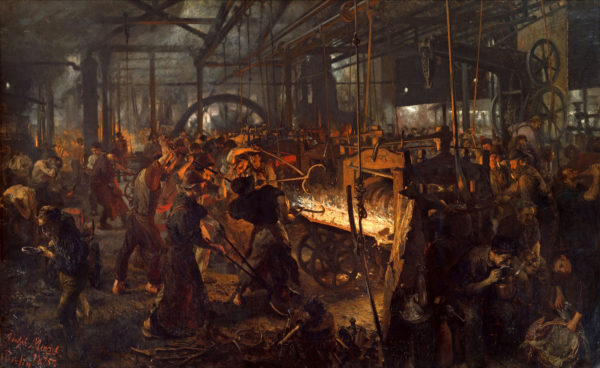
Neither, though, was Menzel following the conventions found in depictions of metalworking factories at the time where the vast interior spaces and the machinery usually dominated over the figures.8 Rather than order, there is disorder, rather than integration there is a confusing agglomeration of activities, partly occasioned by Menzel choosing a moment when a change of shift was taking place. Competing for attention with the central group of workers, there are men on the other side of the machine poised to receive the rolled iron, as well as a man hauling to another part of the factory a bar of still partly red hot iron that had been beaten into shape by a steam-powered hammer, men washing up after finishing work, men taking a meal break, and a little behind, a man clasping with his tongs a long iron rail (cooled by now from a white to a red heat) emerging from or feeding into another rolling machine. Beyond the confusion of cranks and rods and the flywheel driving the array of largely hidden machines stretching out into the distance, there are figures at the very back on the left working at a glowing puddling furnace, and just discernible nearby the top-hatted figure of a supervisor (fig. 3). Menzel captured pictorially a particularly significant feature of the organization of work in a large iron-forging factory. The system regulating the confusing array of laboring activities cannot be made visible but is an intangible presence somehow holding the palpable appearances of the scenario together and assimilating them to a larger purpose—the efficient and cost-effective industrial production of large quantities of iron rail.

While in literature the eruption of open conflict between capital and labor in industrial strikes was beginning to be represented by the mid-century, it was not until the 1890s and turn of the century that this occurred to any serious extent in artistic picturings of contemporary life. Such a situation makes it all the more fruitful to examine the few exceptions that stand out as serious attempts to depict a scene of strike action. Again, as with Menzel’s Iron Rolling Mill, these works rendered the strike as a situation rather than a single conclusive event, thereby opening up the scene depicted to a bourgeois audience’s politically varied understandings of and concerns about strikes as manifestations of underlying social conflict.9
Robert Koehler’s The Strike (fig. 4)—the artist, German by origin, remained for the better part of his career in the United States, but had returned to Germany to complete his training—is a work which at one level envisages the strike as a head on confrontation between the factory owner in a top hat standing on the elevated portico on the left and the gesticulating worker below him to his right.10 At the same time, it disperses this focused drama over the various actions and responses of the assembled figures, so it comes to stand for a more generalized social phenomena, a stand-off between capital and labor rather than one between a manager and the leader of an “army” of workers. The work struck a strong chord at the time, prompting extensive critical assessments of its pictorial conceptualizing of strike actions and their political significance, as well as wide critical acclaim when exhibited in New York in 1886 and in Munich two years later.11 That it was not seen as threateningly controversial can partly be attributed to its not being associated with a particular strike—critics variously placed the scene in England, Belgium, Germany and the United States, and were vague about the identity of the factory buildings from which striking workers are shown streaming toward the owner’s mansion. Given the black country setting, the suggestion that these were foundries would make sense, but the artist seems deliberately to have left their precise identity open.
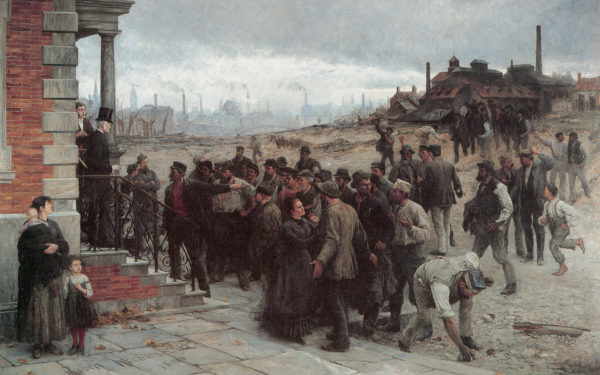
The suggestive impact of the painting has a lot to do with its skillful combination of motifs readily recognizable at the time as paradigmatic of the social conflicts engendered by a major strike—motifs that can also be traced in novels of the industrial scene from Charles Dickens’s Hard Times (1854) and Elizabeth Gaskell’s North and South (1855) in the mid-century to Émile Zola’s Germinal (1885), which was almost exactly contemporary with Koehler’s painting. These motifs include the stiff top-hatted factory owner confronted by a worker activist holding out his arm in reproach, the threat of incipient violence enacted by the worker bending down to pick up a stone to hurl, complemented in turn by the woman, who would be seen as representing a voice of mediation, trying to restrain one of the workers, and the group formed by the woman and children at the bottom left whose plight alludes to the poverty of the families of workers subsisting on low pay, as well as the further hardship they endured when the men were out on strike. Finally, there is the dramatic contrast between the workers’ factory environment on the right and the factory owner’s luxurious dwelling on the left, set in fictionally close proximity to give the disparity visual punch. The painting is less a depiction of a strike than a scenario which invites the viewer to reflect on the nature of such strikes and their roots in stark divisions within the social fabric, even as it deploys visual facts that are individualized enough to make the scenario come alive for the viewer as a reality rather than a merely stereotypical drama. In its own time, as a painting shown in exhibition, it spoke to middle-class anxieties about and concern with the social problems of modern industrialization, while much later when rediscovered in the early 1970s it would be taken up as an image of labor activism by the American trade union movement.12
Characteristic of artistic production in the nineteenth century are these isolated instances of ambitious experiments with subjects that tap into larger public concerns and anxieties. They take the form of singular public statements in which the artist departs from his or her own favored motifs and tries out a subject ungrounded in ongoing practices of visual representation. Such works, while exceptional, are to be valued for the way their motivating conceptions and sources derived to a considerable degree from ideologically charged material located outside the limited purview of visual and artistic culture, as well as for their artistic ambition. The conjuncture of impulses shaping their formation had in part to do with the artist trying out a topical subject that had not been pictorialized before and rendering it in such a way that it was visually compelling, making it stand out at exhibition through its powerful, if potentially controversial impact, and drawing the attention of critics and the artistic public. At the opposite end of the spectrum was work that exploited a motif that was internal to the visual imaginary of art and was then modified so as to project a charged social issue of the moment, of which scenes of agricultural labor were an important instance.
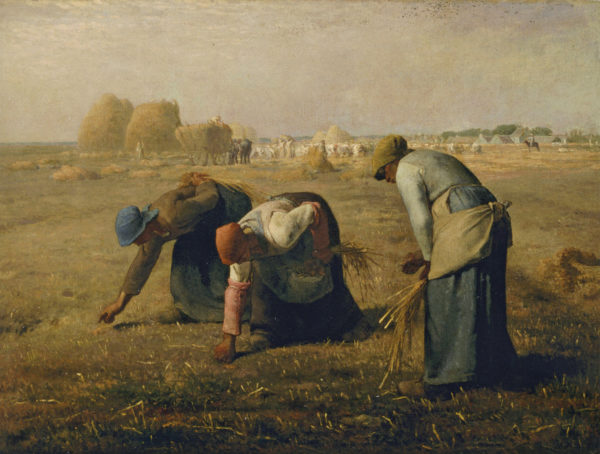
Jean-François Millet’s Gleaners (fig. 5), for example, is much more than a picturesque depiction of a long standing, although at this juncture threatened, custom of allowing poorer women to gather scraps of grain left behind after a field had been harvested.13 Millet has shifted the register of pastoral versions of the motif by bringing out the back-breaking nature of the physical labor involved, and by setting off the foreground scene of the women’s individually pursued efforts with a background one of the coordinated labor of a corvée of workers, bundling and gathering the harvested wheat onto wagons.14 The distant vision of repetitive, mechanical-seeming work carried out under the watch of a mounted foreman (fig. 6) and the relative barrenness of the flat, largely featureless expanse of field—the latter has nothing in it of a conventional pastoral picturesque—parallels in some ways the bleak material conditions and the regulated work routines of a factory, which the rigidly repeating actions of two laboring women in the foreground effectively re-enact on a large scale. The distant field workers, like factory operatives, were hands reduced to the condition of wage or piece-work labor, and as far removed from the situation of the independent peasant farmer as were the impoverished women in the foreground bowed by incessant, meagerly rewarded toil.
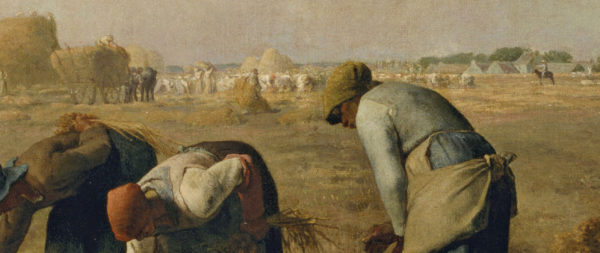
Social Theory
Several key features of the social theory of the period help to illuminate the ideological and cultural pressures that give a larger resonance to such depictions of rural labor, both in their earlier Realist and later Naturalist forms. There was first of all a shift from more purely political to social considerations in the radical thinking that got underway in the years leading up to the revolutions of 1848. The more pressing concerns about the persistence and growth of inequality and class conflict, it seemed, could not just be addressed at the level of the political and the legal, but had to take into account the social effects of the workings of the larger economy.15 A central issue was the way in which, with the new industrializing system operating in the production of material goods, the wealth generated was being distributed in a radically unequal way between the owners of property and capital and the rising population of propertyless wage workers. Among reformers as well as the more radical socialists, the idea took hold that this economic nexus, and the class relations and conflicts it produced, had to be addressed if any real political change was to take place. The point was summed up succinctly by Marx in his critique of Proudhon’s socialist thinking published in 1847: “There is never a political movement that is not at the same time social.”16 Proudhon in fact did concur with the general drift of Marx’s declaration. However, he differed from Marx in his insistence that the pursuit of political conflict would not help bring about the needed social transformation of the present mode of capitalist, property-owning production. This led him to take a more extreme position on the precedence of work and economic production over purely political considerations: “public reason has gained the certainty that politics is impotent as regards the amelioration of the fate of the masses; that the preponderance of ideas of power and authority have begun to be superseded in public opinion and in history by the preponderance of ideas of work and exchange.”17
Possibly the most elaborately articulated case for the pre-eminence of the social over the political is to be found in the writing of a German pioneer of social theory, Lorenz von Stein. In 1850 he published an extended analysis of social movements in France from 1789 to the dying days of the Second Republic, prefaced by what he conceived as a new “Theory of Society” which he hoped would help people understand the social crisis of their time, and encourage governments to take measures to address the inequalities structural to the operations of capitalism (at this juncture he had in mind a social democratic political alliance of progressive forces to effect this, but later became a proponent of authoritarian regulation of reform from above by the state). Any serious social reform, he insisted, “must, if it is to be capable of making something possible in the external world, begin its battle with external goods. The external good is the product of bare material and work.”18
This brings into play the central role played by work in the political economy and social theory of the period. Work was already fundamental to the theorizing of political economy in Adam Smith’s The Wealth of Nations, which begins with the declaration: “The annual labor of every nation is the fund which originally supplies it with all the necessaries and conveniences of life which it annually consumes.”19 Proudhon was probably the most eloquent champion of work as both the origin of the production of the goods on which society depended and a defining purpose of human existence: “Work is the intelligent action of man on matter; work is what distinguishes, in the eyes of the economist, man from animals, to learn to work, that is our goal on earth.”20 What taxed him was degeneration of the conditions of labor that resulted from capitalist exploitation of production. The division of labor, in his view as in that of most of his contemporaries, was fundamental to material progress and could, when properly organized, enhance the quality of the laboring process, activating the mind and imagination of the worker through its increasing complexity as well as its refinement of the performance of work.21 What is more, the collective force realized by the division of labor and the cooperation it involved made it the basis of social solidarity.22 In present-day manufacture and industry, however, driven by the interests of capital, the division of labor had been reduced to something inhuman and barbaric through a minute compartmentalizing of the individual’s labor into unending repetition of the simplest mechanical task. This utter degeneration of labor, in his view, was having a devastating effect on the work force, reducing the inhabitants of the main industrial centers to an alarming level of corruption and barbarism, not of their own making. They were no longer workers in the true sense of the word: “Should I call workers those unfortunate human figures who spend their life at the bottom of a mine or in the infection of a workshop, endlessly repeating the same particle of work, like the pestle of a mortar, the striking of a clock, and the hammer of a forge.”23
For Marx labor had a similar double character. In his early writing he spoke of labor in its most general sense as a combination of “vital activity” and “free conscious activity” defining “the species character of man”; but actual labor as wage labor realized under the conditions of modern capitalism no longer had this quality and had become abstracted and alien for the worker.24 He would attack Adam Smith for envisioning labor as a curse that had to be endured. In addition to being submission to a task, labor, he argued, could also take the form of “self-realization” in the process of overcoming the material obstacles involved when the task was entered upon freely. At the same time, he pointed out, Adam Smith was correct “in saying that labor has always seemed repulsive, and forced on the worker from outside, in its historical forms of slave-labor, bond-labor and wage labor.”25
In Capital, he would highlight the potentially invigorating nature of the collective work carried out on a co-operative rather than individual basis:
Apart from the new power that arises from the fusion of many forces into a single force, mere social contact begets in most industries a rivalry and a stimulation of the “animal spirits” which heightens the efficiency of the individual worker … This originates from the fact that man, if not as Aristotle thought a political animal, is at all events a social animal.26
Under capitalism, however, the formal co-operation involved when workers were engaged together on a task ceases to have any real meaning for them. They had sold their labor to the capitalist: “They enter into relations with the capitalist, not with one another” and remain “isolated.”27 His complex discussion pointedly avoids the easy moralizing laments common at the time about the degrading labor to which the working classes were subject and the outright evil of the modern system of division of labor. At the same time, the painstaking analysis of co-operative forms of labor he offers in Capital makes evident the very real interest he had in the concrete details of different working processes and their organization, as well as his attentiveness to the on-going importance of earlier kinds of production and laboring that persisted within, while also being largely subsumed by, the operations of capital accumulation and circulation.28
The way radical thinkers like Marx and Proudhon made labor the focus of their larger analysis of modern society, and of the disparities of wealth and levels of deprivation engendered by industrial development and capitalist exploitation, had a particularly fruitful aspect lacking in more straightforward critiques of social problems which engaged people at the time. Of these, poverty stood out as the single most important concern—the most pressing “social problem.” Taken on its own, it had to do mainly with deprivation, whereas labor was necessarily more complex and far-reaching. As the driving power behind the production of goods and wealth, it was central to the entire realm of the social. At the same time, as exploited under a capitalist system, it lay at the core of the economic deprivation of the working classes. Thinking of labor in such dialectical terms meant that the working classes were not simply represented as victims but also as potential agents.
A similar distinction can be made between scenes of laboring and those of impoverishment in social realist art. There are powerfully uncompromising paintings of extremes of poverty that grant a level of integrity to their human subjects, as Linda Nochlin shows in her fine recent study Misère: The Visual Representation of Misery in the 19th Century.29 But scenes of impoverishment were prone to sentimentalizing exploitation and were often devised with a view to eliciting indulgent feelings of pity for its victims. The ragged figures featured in scenes of poverty were generally depicted as outcasts of the social system. Laborers, by contrast, including those employed under conditions of brute compulsion, were essential to society’s inner workings. This said, pictorial renderings of scenes of poverty, like those of labor, registered a growing awareness of and concern for class politics amongst the period’s bourgeois audience for art.
In the depictions of working-class labor that feature in the realist art of the mid-century and in subsequent Naturalist or late Realist work, the setting is almost always rural. As a result, such scenes tend to be seen as evading the realities of modern conditions of industrial labor. What was sometimes happening, though, was a transposition of a broader concern with work onto depictions of situations that conformed to a traditional privileging in visual art of natural or rural settings. Moreover, the agricultural and the rural were hardly marginal forms of reality for a significant portion of the population. Even in Britain the rural population was not exceeded by that living in an urban environment until the mid-century, and agricultural laborers continued afterwards to form a key sector of the working population. At this point they still outnumbered those employed in industry.30 Through much of the century, as Eric Hobsbawm put it, “for by far the greater part of humanity, the fortunes of life still depended on what happened to and on the land.”31 While changes in working conditions were not as dramatic as those in manufacturing, a capitalist reconfiguring of conditions of labor, along with ownership of land and agricultural practice, proceeded apace in the countryside. Significantly, Marx’s study of modern capital includes extensive discussion of the capitalizing of agricultural production and the impoverishment of agricultural worker under regimes of wage labor.32 Mechanization was slower in agriculture than in industry—harvesting machines and machine-driven ploughing did not become economically viable on a widespread basis until late in the century, though steam powered threshing machines were already being utilized by the 1830s and 1840s, particularly in Britain.33 A good deal of the laboring in agriculture was still traditional, physical work, so the focus on these in visual art is not necessarily to be seen as pastoral or retardataire, though it often became so by the turn of the century when such motifs had been thoroughly internalized by the mainstream art world as picturesque material.
Interrelationships between the concern with labor in social theory and the thematizing of laboring in the visual arts seem clearest in the moment when a veritable explosion of theorizing was followed closely by the emergence of a new realist art during and in the immediate aftermath of the upheavals of the 1848 revolution. Some connections are quite direct. Critics such as Théophile Thoré, who was also a known political activist, began championing the idea of an “art social” in the 1830s and 1840s.34 In Thoré’s case this included laying the groundwork for advocating the idea of a modern art that would truly picture its own times, in the way he like others imagined the Dutch had done; and later he went on to champion the work of artists such as Gustave Courbet and Millet. Proudhon towards the end of his life embarked on a book about Courbet in which he envisaged the artist’s work as paralleling the theorizing of philosophical writers regarding “the right to work and the right of the worker, announcing the end of capitalism and the sovereignty of the producers.”35
The situation is rather different with the Naturalist and late Realist works of the 1870s and 1880s. The significant turn at this juncture towards artistic representations of scenes of hard rural labor does not have as evident a cultural or political parallel in a clearly defined body of writing as did the earlier realist impulses that took shape in the 1840s and early 1850s. For one thing, the ambitious attempts to anatomize the new social and political order and new political movements—socialism and communism—in the period leading up to the revolutions of 1848 continued to set the broader parameters for much subsequent thinking on the subject. New approaches to analyzing the social only seriously got underway towards the end of the century, when sociology was establishing itself as a formal discipline. Significantly, Marx’s critique of capitalist political economy in Capital, itself grounded in the intellectual and political world of the 1840s, did not begin to gain widespread recognition until over a decade after its initial publication in German in 1867 (the first English edition only appeared in 1887). Still, a shift in the politics of thinking about the social is suggested by the appearance of two German publications on the Arbeiterfrage in 1865 and 1868 almost simultaneously with (but entirely independently of) Marx’s Capital. Their focus on the “worker question” (as distinct from the “social question” which nevertheless remained a common point of reference)36 had obvious connections with related political developments—most notably the formation of political groups that represented workers’ interests, starting in 1863 with the creation of Ferdinand Lassalle’s German Workers Association and the formal constitution of the Socialist Workers Party of Germany (later the Social Democratic Party) in 1875. By the 1880s socialist or workers parties were becoming a significant political presence elsewhere in Europe. At this juncture too, governments came under pressure to establish systems of social welfare directed to the working classes.37 Immanuel Wallerstein, in his overview of nineteenth-century labor and social movements in the aftermath of 1848, offers a suggestive periodization of this early evolution of socialist thinking and activism: “1815 to 1851—‘powerful idea…, weak movement’; 1851 to 1871—‘movement on the rise, idea in decline’; 1871 to the end of the nineteenth century—‘powerful idea, powerful movement’” — though the 1871 transition here seems a little premature for a re-engagement with any “powerful idea.”38
After a period of reaction which had gripped most of Europe in the wake of the revolutions of 1848, the political climate began to shift in the late 1860s with a liberalizing of government restrictions on political life along with a slow revitalizing of proletarian and socialist activism.39 In France the legal suppression of combinations of workers and strikes which had been in place since 1791 was partially lifted in 1864, while in Britain, where the situation had been more favorable to union activity once a temporary ban on unions had been lifted in 1824, the right to strike was given legal recognition with the passage of the Trade Union Act in 1871. The larger social and political context was also being shaped by the onset of what has been called the long depression. This got underway with a banking crisis in 1873 and extended into the early 1890s. While it did not result in an economic downturn as severe as that of the Great Depression of the 1930s, it did cause significant economic instability which exacerbated labor unrest and strikes, and in Europe resulted in serious economic difficulties for the agricultural sector, aggravated by cheap American produce flooding the market. The situation was such that the economic conditions of wage labor in the countryside were seen as in many ways comparable to that in industry.40 The depression and its effects go some way to explaining how issues relating to labor and the exploitation of the proletariat, agricultural as well as urban, might have had a particular resonance for both artists and their audience at the time.
The Realist Impulse
Apprehension of the social can be effected conceptually through theoretical reflection on social formations and the structures underlying them—as in the body of thinking variously described as social theory, political economy or sociology. The picturing of the social, though, generally operates in a different mode. In the Realist or Naturalist forms of picturing dominant in later nineteenth-century depictions of modern life, the scene or situation was designed to be apprehended by the viewer as a directly experienced physical reality. An existential awareness of the social, experienced at a level that was not fully conceptually articulated, was where visual art’s picturing came into its own. There are exceptions, most of it printed material, such as George Cruikshank’s curious hierarchical presentation of Britain’s liberal-monarchical-commercial-mercantile social order in his The British Beehive—A Penny Political Picture for the People (fig. 7). A significant exception in the realm of high art is the unusually ambitious painting Work by the British artist Ford Maddox Brown, an elaborate meditation on the nature of work which he presented along with an extensive description at a private exhibition in 1865 (fig. 8).41 Like Courbet’s Studio it is an experiment in “real allegory,” extending the realist conception of the picture to embrace a conceptual complexity more commonly associated with the public mural. The central motif is building work being carried out in a wealthy suburb of London to lay a new pipe line designed to supply fresh water from a nearby reservoir (the setting, a street in Hampstead, is carefully depicted from life).42 It shows both the laboring involved in realizing part of this program of metropolitan improvement and the temporary intrusion it made on the everyday public life of the street. While featuring labor as a necessary and productive activity integral to the functioning of the modern city, it also sets out to picture, through the array of figures surrounding the central scene, different class-based embodiments of work and attitudes to work (as well as not having to work or being thrown out of work) in British society at the time.
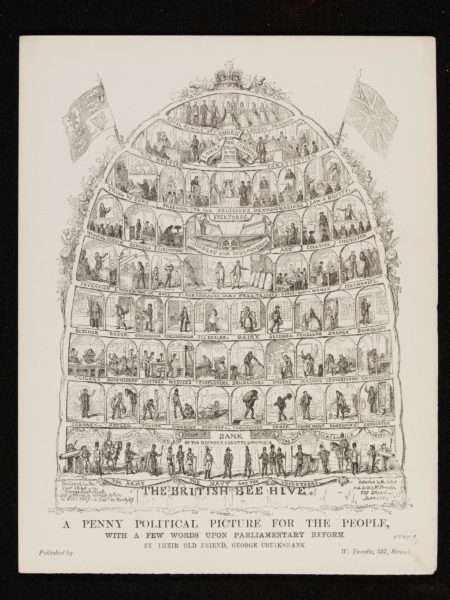
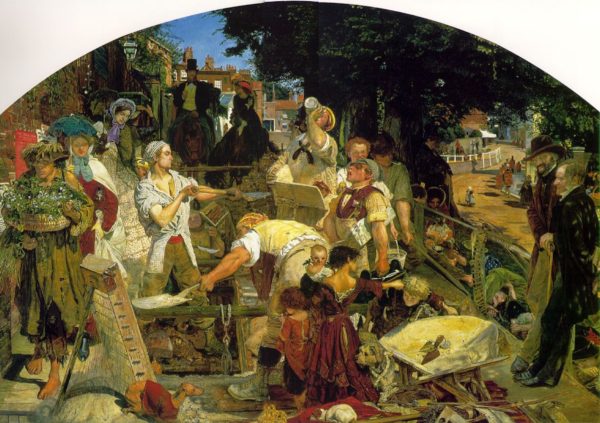
Brown characterized the building work of “the British excavator, or navvy,” not as mere physical labor, but as exemplifying “the outward and visible type of work.” He saw the central figure, the “young navvy in the pride of manly health and beauty,” as occupying “the place of the hero” in the group of workers; but it would be misleading to see Brown as simply heroizing labor. Collectively, the navvies are ordinary men of different age and type, working in the heat of the summer sun, including the slightly sullen looking older man heaving the sand to be used for mixing mortar through a sieve. Brown wanted to make his audience aware of the hazards of this kind of labor. “One incident peculiarly connected with this picture,” he noted in his description, “is the melancholy fact that one of the very men who sat for it lost his life on a scaffold accident before I had yet quite done with him.” Significantly, the central figure vigorously shoveling earth is shown, not firmly placed on the ground, but standing on a wooden platform suspended over a deep pit. Also of note is the group of partially visible figures resting at the side of street beneath the embankment on the right (fig. 9). These Brown designated as unfortunates who are “out of work.”43 They form a presence hovering on the margins of the main scene that cannot be wished away, reminders of the economic uncertainty and instability that can await the laborer, even relatively skilled ones engaged in productive work. Two of the itinerant figures, identified by a pitchfork and wrapped scythe leaning against the embankment above them, are out-of-work agricultural laborers.
An unemployed navvy forms the subject of a later social realist painting by the German-British artist Hubert von Herkomer (fig. 10). This too is one of those one-off, exceptional works that directly addressed a characteristically modern social issue. The painting is usually seen as picturing the situation of the agricultural laborer at the time—in the 1880s and 1890s, rural poverty, as well as poverty in industrial and urban centers, was an issue very much in the public eye.44 Its title, Hard Times, however, echoes that of the one novel by Dickens which deals specifically with an industrial rather than a generalized urban milieu. The tools of the out of work laborer identify him as a navvy or building worker, so not specifically a rural worker, displaced on his forced wanderings in search of employment in this inhospitable bit of countryside. The prospects facing him and his family are exacerbated by their homelessness, a particular problem for navvies who would often have to decamp from temporary accommodation once a building project came to an end.45 If the standing male figure’s situation is bleak—grittily and honestly so—his posture is sustained by a lingering vitality and down-to-earth dignity. He is not shown reduced to a mournful state of total destitution and he still owns his tools. These are hard times, not utterly hopeless tragic ones. He stands there as a subject, not an object of a philanthropically inclined viewer’s pity or concern, and this is true to a degree even of his family, the woman and the two children. Though relatively passive presences, they are not in a state of pitiful collapse, inviting tear-jerking sympathy of the kind often catered to in socially concerned Victorian picturing of the lower classes, but instead are asleep, taking what rest they can.
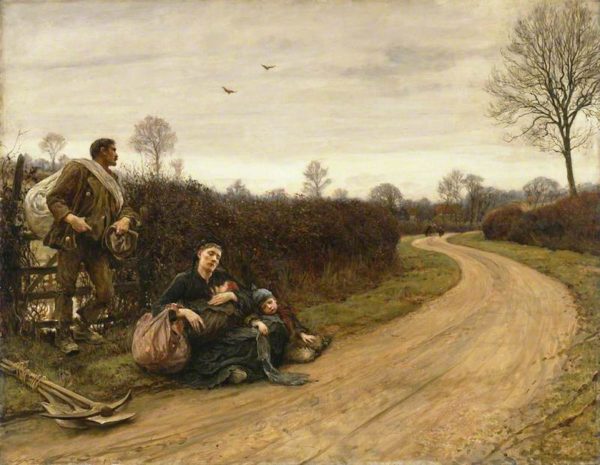
Courbet in his Stonebreakers (fig. 11) did not attempt a broad conceptualizing of the nature of work in modern society in the way Brown did. Rather, his painting offered up a single, vividly conceived scene, and as such became an iconic picturing of labor. It enjoyed a huge afterlife, and was shown in a number of major European venues in the wake of its appearance as an artistic and political cause célèbre at the Paris salon of 1850–51. This pioneering picturing of laboring figures as significant presences in their own right was a major new departure.46 It resonated strongly with contemporary concerns about the conditions of the laboring poor and the possibility of working class unrest.47 While the setting is vaguely rural, and the scene clearly not an industrial one, it still conjured up modern anxieties about the subservience of human labor to routines and disciplines imposed by mechanization in the new industrial economy. Writing in 1865, the anarchist Proudhon characterized the actions of the older man as follows: “His rigidified arms rise and fall with the regularity of a lever. There certainly is the mechanical or mechanized man, in the desolation made for him by our splendid civilization and our incomparable industry.”48 Proudhon also made the important point that mechanization was not liberating the working classes from hard labor, but rather continuing to subject them to degrading work which the bourgeoisie were spared—whether by continuing to exploit poorly paid unskilled labor to carry out tasks such as stone-breaking, much in demand for providing the raw materials needed for laying out roads and railways, or subjecting those desperate for the barest remuneration to the “crudest, the most painful, the most repugnant forms of work” created by the new industries.49
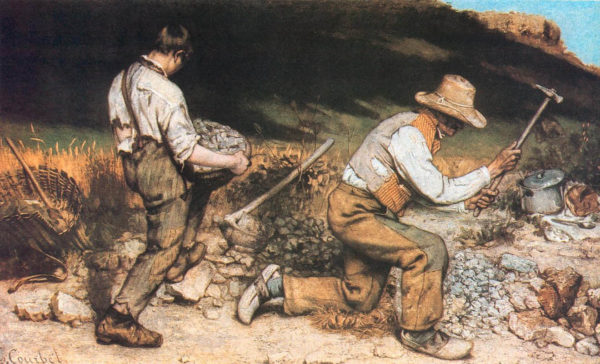
While Stonebreakers persisted as a canonic representation of laboring well into the period of Naturalism with its proliferating depictions of rural field labor, Courbet himself did not return to the subject of hard physical work. One slightly later painting, The Grain Sifters (fig. 12), may depict physical work, and even offer up a low-key picturing of the processing of harvested grain, but it would be hard to see it as engaging seriously with a politics of labor, except perhaps in its gendered dimensions. As Courbet himself suggested, it is more in the nature of a “picture of country life.”50 At a stretch, his monumental landscape Siesta During the Haymaking Season, 1868 (Petit Palais, Paris), might be interpreted as an honest projection of what, for a farm laborer, slogging it out in the heat of the summer sun, was the best part of the working day—taking a break and enjoying a brief moment of flat-out rest and sleep in the shade. Here however the exhausted oxen rather than any human figures bear the brunt of evoking the burden of hard physical labor.51
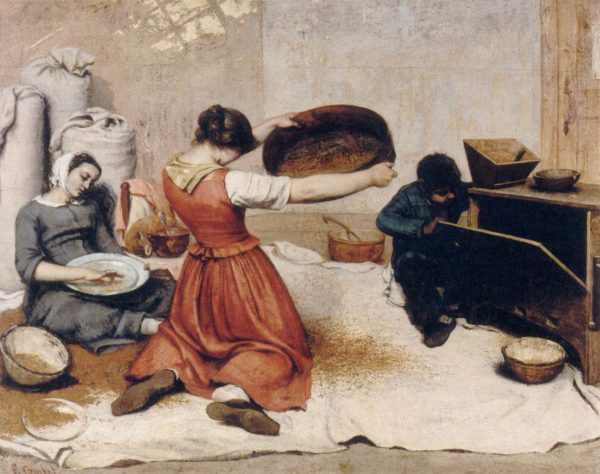
Millet, along with Courbet, was and is widely recognized as a key figure in the realist turn to depictions of rural labor that got underway in the mid-nineteenth century. After making his mark in the early and mid-1850s as a controversial painter of the harder aspects of the rural life (fig. 5), he achieved a canonical status internationally as the painter of the laboring peasantry. More so than Courbet, he featured in later critical writing as a model against which to measure the achievements and shortcomings of Naturalist depictions of the laboring poor. While his relatively small-scale easel paintings were without the overt public ambitions of Courbet’s Stonebreakers, a number were justifiably seen by contemporaries as serious attempts to picture the hard conditions of life amongst the poorer sectors of the rural working classes—though Millet was no socialist and saw himself as depicting in such images the unchanging lot of the working poor.52 Like many of his contemporaries, he produced a number of more conventionally pastoral images which were valued (and sometimes denigrated) for featuring the peasantry as models of the simple life and pious observance, or as naïve embodiments of an originary Frenchness best preserved in the remote countryside.53 Several of these paintings are redolent of traditional family values, and offer an idyllic vision of the independent self-supporting family unit (fig. 16), bracketing out the indications found in a number of later Naturalist paintings of field labor that such family-based groups were often employed as part of a larger workforce dispersed over a landowner’s fields.54
The Naturalist Picturing of Labor
Realist picturing of farm labor soon became quite conventionally pastoral in the wake of Courbet’s and Millet’s early experiments—usually featuring attractive maidens working in slightly rough and earthy but picturesquely atmospheric conditions (fig. 13). Then, in the 1870s, a newly reconfigured painterly Realism emerged that in some ways parallels the “factual” aesthetic and distinctive class inflection of literary Naturalism in the period. In both the novels of writers such as Zola and Naturalist painting, unvarnished representations of lower-class subjects and a proletarian milieu played a significant role alongside the ongoing “modern life” representations of the world of the bourgeoisie. This new tendency gave rise to a number of ambitious, often large-scale works, visualizing some of the rawer realities of hard rural labor. Such painting became quite widespread in Europe from the late 1870s through to the early 1890s (figs. 14, 15, 17, 18, 20), a period when a number of social and political factors converged to place issues relating to the economic situation of the working classes center stage.
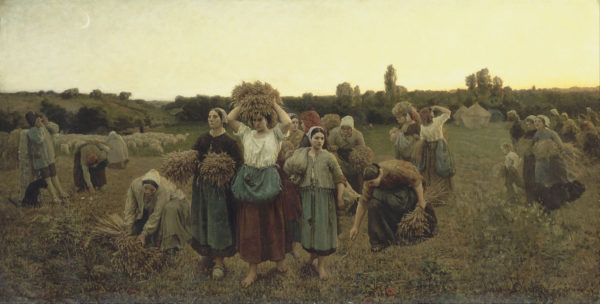
A key figure internationally in this shift to a new kind of socially and politically resonant rural naturalism was the French painter Jules Bastien-Lepage. His Haymaking, depicting two exhausted hay-harvesting workers, had a major impact when it was shown at the 1878 Paris Salon (fig. 14). As a recent study by Marnin Young has made clear, this is a scene of rural wage labor, rather than traditional peasant life, though mitigated by isolating the husband wife team and setting the other field laborers engaged in harvesting the hay in the far distance.55 What is “Naturalist” about this painting is both its exacting painterly depiction of the visual and material texture and atmosphere of an open sunlit hayfield, taken together with the way it directly faces the viewer with the bare reality of the figures’ utter physical exhaustion. Theirs is not a pleasurable break from the toil of scything the grass and then raking it (the female work). The tools are just visible, party hidden by the grass, a little above the stretched leg of the prone male figure. Rather it shows them still in the grip of their enforced laboring. The insistent presence of the woman, absorbed in a state of blank psychic inertia that barely rises above the level of physical sensation, with little or no suggestion of inner thought or feeling, both infuriated and fascinated critics who found their habitual response to more conventional pastoral images of the female field worker temporarily interrupted. The international as well as national impact of this kind of work was huge, as can be seen in the painting Winter Work by an avowed British follower of Bastien-Lepage, George Clausen (fig. 15).56 His scene of workers pulling and trimming mangolds—a root vegetable grown as animal feed—was complemented by a pastel showing the mangolds being fed into a slicer in preparation for their being fed to a flock of sheep—testimony to new practices of intensive farming which made it possible to raise sheep in small fields alongside crop growing rather than traditionally in areas of open pasture.
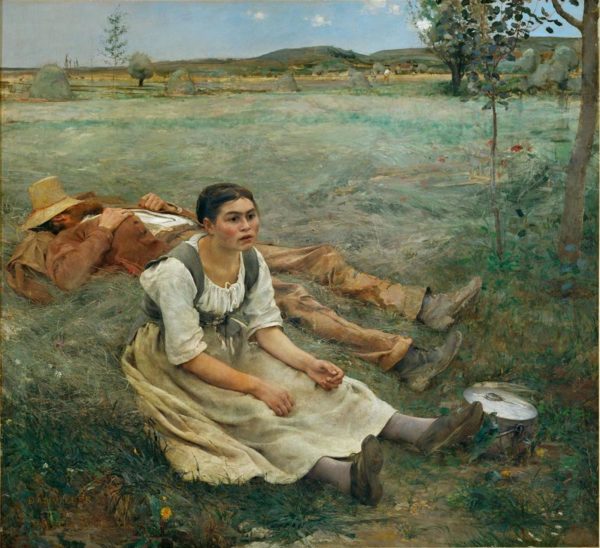
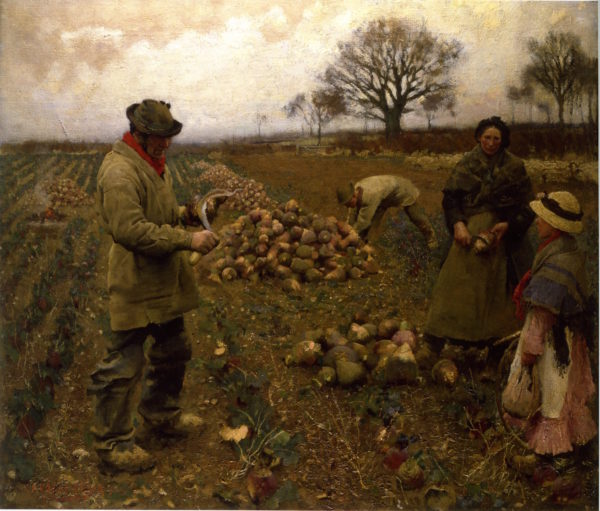
This Naturalist work is significant in part because, like realist art in its more radical earlier form, it took the figure of the working-class laborer as a presence to be reckoned with rather than appropriated by picturesque visions of supposed rural simplicity and naturalness. It also deserves attention because it takes up seriously the depiction of different forms of the social organization of labor. Various levels of coordination and regulation of the work process are detailed, ones that operated in agriculture as well as industry. There is firstly the very traditional social form of laboring, that of the individual worker, or intimate group of workers, operating independently (fig. 16). Such scenes in art often featured the type of the mythic village peasant or artisan who subscribed to no master’s call (except of course that of financial need, which dictated the onerous work hours required to make a living). There is a further superficially similar form of laboring in which the work of individuals or smaller groups, while relatively autonomous, is incorporated within and regulated by a larger enterprise—the figures in pictures of field labor, for example, are often not independent producers working a patch of land they owned or rented, but wage laborers employed by the owner of an estate to carry out tasks requiring multiple hands such as harvesting (fig. 17). Thirdly, there are forms of collective laboring carried out on a more fully synchronized and regulated basis (fig. 21), of which work in some of the larger factories would be the most dramatic instance.
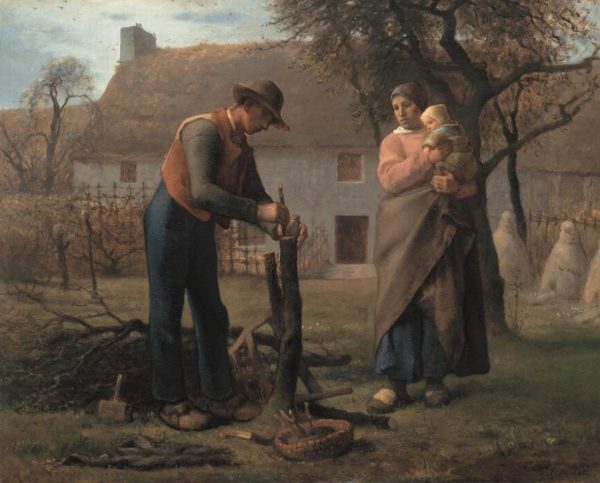
Naturalist art often featured the second, partly coordinated form of labor, as in the monumental painting of beetroot harvesting in winter by the Belgian painter Émile Claus (fig. 17). Here, if one looks closely, it becomes apparent that the working group in the foreground is complemented by other groups scattered across the further reaches of the flat expanse of field. For critics, the power of the picture lay in its unstable concatenation of hard social reality and compellingly atmospheric rendering of a rural scene. One critic for example commended the painting for successfully combining “powerful realism” in the foreground with “grand fluidity of atmosphere” in the distant view.57 Others noted the feeling conveyed of “the rich land, the currents of air,” “the great beetroot” alongside the powerful presence of “the dehumanized slaves working in the field.”58 Farming beetroot as a cash crop was a relatively modern development at this juncture. Sugar beets were being cultivated on a large scale to cut back on sugar imports form the Americas. Also, in the North of France and Belgium coal mines were often located in the midst of fields where, among other crops, beets were being grown.59
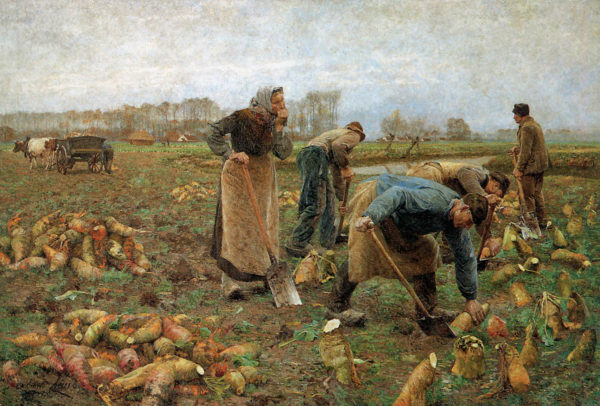
Claus depicted a much more rigidly coordinated form of field labor in another painting of workers weeding a flax field (fig. 18). What marks this out is not just its success in giving pictorial form, through the row of workers slowly making their way across a field, to a closely regimented laboring that operated on a more intensive basis in the new industrial concerns. It also vividly stages the dulling, slightly distracted attentiveness demanded of incessantly repetitive work of this kind (fig. 19). The artist made a point of subtly articulating the workers’ varied levels of engagement, ranging from mindless absorption in the task at hand to exhaustion and snatched moments of low-level social interaction. The commanding gesture of the standing woman in the center marks her out as the supervisor keeping watch; but even she seems caught between the focused attentiveness demanded of the work being done (in her case watching over and regulating it) and a momentary distracted looking out over the field.
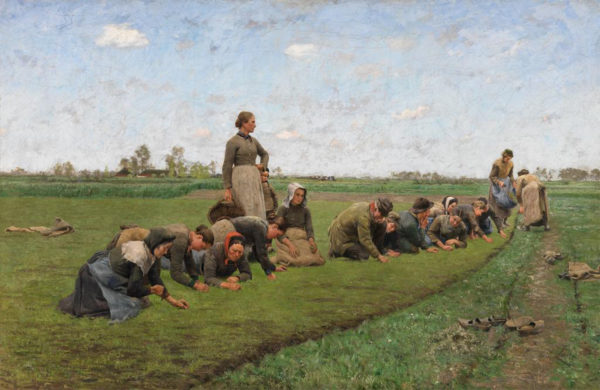
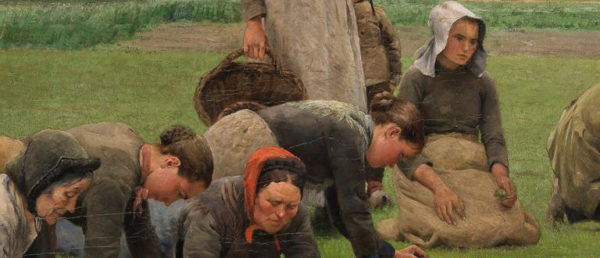
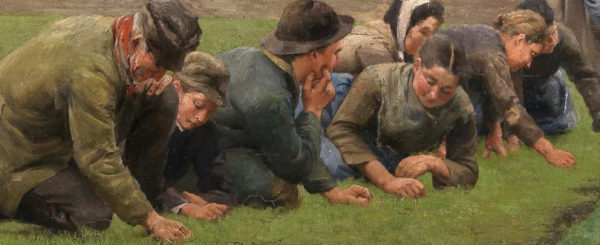
The German painter, Max Liebermann, who before he turned to an Impressionist way of working in the later 1890s and shifted the social center of gravity of his work to more bourgeois milieus, made his name as a Naturalist and produced some of the more effective and gritty paintings of rural labor in the period (fig. 20). In his painting The Flax Barn he also experimented with depicting a work scene that related more immediately to the industrial economy of the period (fig. 21). It pictures a relatively traditional manufacturing process, carried out in a rural rather than urban or industrial setting in a part of Holland where, as in many parts of Europe, manufacturing continued to operate without steam power using older forms of wooden machinery. At the same time, the coordinated factory-like structuring speaks more directly to the social organization of labor in modern industry than field laboring scenes. The setting is a reasonably large flax-spinning establishment or flax barn in Holland devoted to the production of the thread that would be woven into linen. The children on the left are doing the drudge work keeping the spinning wheels turning. The women’s more skilled work operates in two phases—first they move backwards, teasing out from the bundle under their arm a string of flax fiber which is being spun by the action of a whirling spindle in one of the machines on the left; then, once a full length of thread has been spun, and the spindle reoriented so the spun thread begins to wind around it, they move forwards, guiding the thread as it is wrapped around the turning spindle. In contrast to the variety and seeming confusion of working activities in Menzel’s slightly earlier industrial scene, Iron Rolling Mill (fig. 2), here one sees a systematically ordered, strictly synchronized form of labor common in textile manufacture that was developed most fully in the mechanized textile mills of the period. This highly regulated organization of the laboring process is dramatized pictorially by Liebermann through the tightly structured compositional ordering, with the grid-like lay-out of the interior paralleling the measured back and forth movements of the female workers. Significantly, Liebermann here is giving pictorial form, not only to a strictly ordered spatial organization of labor, but also to a temporal regulation and synchronizing of the workers’ movements. The painting met with almost immediate official recognition, entering a public collection, the Nationalgalerie in Berlin, the year after it was painted, where it still holds pride of place as a depiction of labor along with Menzel’s Iron Rolling Mill which, as chance would have it, had previously been owned by Liebermann’s uncle.
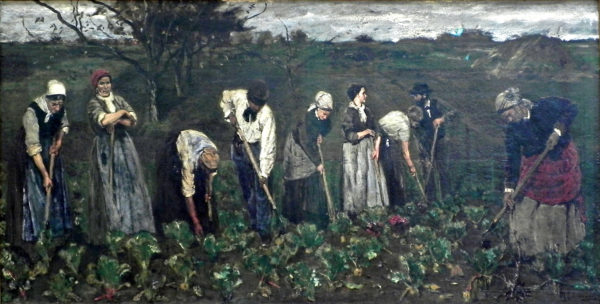
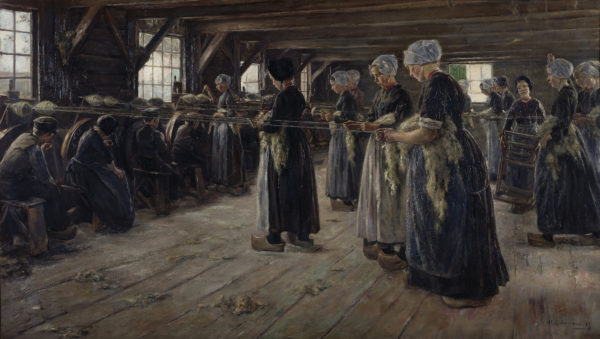
How Liebermann’s Flax Barn spoke to viewers at the time of larger concerns with the modern organizing of labor and the conditions of factory-like laboring, as well as to a middle-class fetishizing of hard work, is evident from the range and intensity of ideologically charged responses it elicited. One critic complained about the unrelenting presentation of “everyday mechanical work”; another saw the rendering of collective absorption in a basic, repetitive labor process more positively, commenting how, in conveying the atmosphere of the strictly ordered working space where only the humming and purring of the wheels would have been heard, “The great word ‘work’, the motto of the nineteenth century, speaks loudly to us.”60 Later, one critic came up with a particularly revealing comment on Liebermann’s preoccupation with collective laboring, this time as realized in his painting Workers in the Beet Field (fig. 20): “Though each figure is also well characterized, the picture was not painted for such individual characterization. It was painted because the artist was seized by the pathos of work and by the beauty of this massed group that was to certain extent stylizing itself under the compulsion of the same activity.”61 The Flax Barn too is notable for its visualizing of the social dimensions to the worker’s incorporation within a structure of collective laboring—on the one hand there is the individual women’s absorption in a relatively smoothly coordinated work process (fig. 22), and on the other their subjection to a highly regulated pattern of repetitive tasks. For contemporaries, Liebermann’s painting, while not directly depicting factory work, gave visual form to the inherently conflicted social character of factory laboring—its efficient integration of workers’ efforts in a synchronized system of production, later very attractive to modernists, but equally its imposing on workers a coercive regime of enforced productivity.
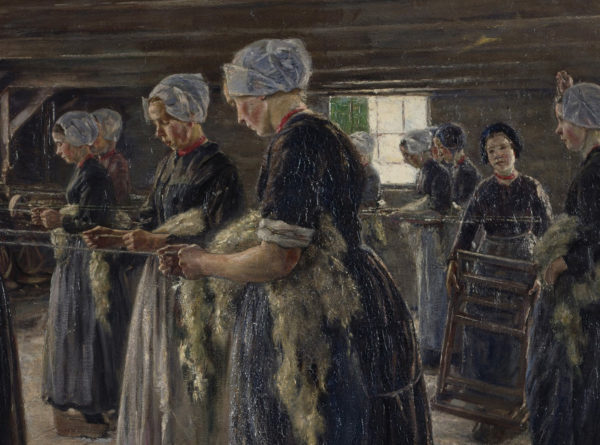
Liebermann’s Naturalist painting brings into focus a significant aspect of Naturalist depictions of the material conditions of working-class laboring, namely that the pictorial paradoxes inherent in the successful visual rendering of such scenes echo at some level those of the contending social and political currents in the phenomena depicted. In the Flax Barn, the finely inflected, almost geometric clarity of the open space and of the figures’ placement within it creates a sense of order and measured containment, but one that is also somewhat oppressive or unyielding. The subtle play of subdued, evenly distributed light gives a felt fullness to the expanse of space and a barely perceptible warmth and muted animation to the environmental features and figures it illuminates; but it also throws into relief the general drabness of the environment and its suppression of spontaneous animation. At the level of pictorial effect the painting delivers an undeniable aesthetic charge that is both engaging but also incipiently alienating. The labor being figured might momentarily strike a view as reassuring, possibly as a triumph of finely coordinated and productive manual work; but there is also rigid regimentation. The figures are subjected to the imperatives of a larger force sustaining the steady output of yarn by ensuring that the machinery keeps spinning and the workers continue feeding and servicing it efficiently. That it is hidden and seems not to require the agency of human supervision makes it all the more powerful and pervasive. In the final analysis one is presented neither with straightforward celebration nor straightforward critique of labor, though possibly a bit of both. In this respect the picturing is true to the material realities of a laboring carried out under the aegis of a capitalist system of production. There is the unceasing pressure of exploitation and coercion which subsumes, but never entirely, the actual laboring process; the laborer is to a degree dehumanized, but retains a residual integrity and a low level of subjective engagement with the work she carries out. The more degradingly inhuman factory conditions of the nineteenth century largely extinguished such possibilities, but this could not be said categorically of labor in general at the time. Realist picturing of work, because of the overlay of pictorial aesthetics integral to a compelling depiction, tends to a bias in the more positive direction. This article is designed to prompt thinking about the give and take between the complexities and deep-seated tensions lodged in understandings of labor in the nineteenth century and the more easily negotiable complexities and tensions of an artistic realism attempting to picture the realities of labor by drawing on, but also to an extent resisting, the aesthetic compulsions that fully engage a viewer.
Notes
The politics of the social was central to public and cultural life in nineteenth-century Europe and gave rise to an important body of writing on social theory and political economy. Karl Marx’s celebrated critique of the devastating social effects of the new, rapidly industrializing and capitalizing economy, starting with his early writings in the 1840s and culminating in his magisterial study Capital (1867), formed part of a widespread, if less brilliantly focused and politically compelling, analysis by writers of a variety of political persuasions. Their diagnosis, like Marx’s, addressed deepening disparities of wealth and intensifying conflict between capital and labor, as well as the emergence of the proletariat as a new social and political force to be reckoned with. Such concerns were not in any way exclusive to radical socialist and communist or anarchist thinkers such as Marx and Pierre-Joseph Proudhon. Amongst reformers keen to forestall revolution and apprehensive about working class activism, there was a lot of talk about the “social problem” or the “worker question.” John Stuart Mill’s Principles of Political Economy, the standard text in English on the operations of the modern economy and its social consequences for several decades after its initial publication in 1847, included a serious, and even in ways sympathetic, assessment of the radical critique of modern capitalism by prominent socialists such as Louis Blanc—who, incidentally, was the brother of Charles Blanc, later to become became a key figure in the official French art world.1

The possible interrelationship between these developments and depictions of contemporary life in art of the period have been the subject of extensive scholarly analysis, starting with explorations of early artistic responses to the world of modern industry pioneered by the Marxist sociologist and art historian Francis Klingender in his classic text Art and the Industrial Revolution (1947).2 Nevertheless, while the move towards a social history of art that got underway in the 1960s and early 1970s has given rise to an important body of scholarship centrally concerned with the social and political dimensions of artistic representations and practices, histories of nineteenth-century art still feature very little in the way of depictions of industrial work and the condition of the working classes, let alone social conflict, and this is not just a retrospective formalist bias.3 Such imagery is found in the printed media but only occasionally in high art. In the latter, direct picturing of the new realities of the world of industry are few and far between. Such subjects are sometimes tackled in Naturalist work seen to operate in a formally somewhat conservative or academic mode,4 but they are almost totally absent from the art of the late nineteenth century that elicits most scholarly interest—the work of avant-gardes such as the Impressionists, where the milieus are generally ones of bourgeois leisure. Social historians of art have been making a compelling case for some time now that there are nevertheless connections to be teased out between the picturing of modern life in the artistically more innovative art of the period and broader questions of social class, connections whose intricacies remain largely implicit.5 Here I want to up the stakes somewhat and consider ways in which a significant concern with the politically charged issues addressed in the new social theory and its critiques of modern capitalist society did manifest itself more directly in a range of later nineteenth-century artistic depictions which deserve to be recognized as aesthetically compelling.
Firstly, account needs to be taken of the few instances of a picturing of the new world of the modern factory and factory labor in artistically ambitious art of the period. My main purpose, however, will be to examine a more pervasive, socially charged motif widely exploited by Naturalist and Realist artists, namely scenes of rural labor. Without directly representing modern industry and factory work, such picturing of field labor formed a nexus around which realist artistic tendencies and social theory were able to converge. Something of a paradigm shift occurred from previous treatment of scenes of working-class life. These had operated in a largely comic or quaintly picturesque mode, modelled on seventeenth-century Dutch and Flemish old master paintings of peasants entertaining themselves and carousing or socializing, but never working.6 My argument is that a concern with the social constitution of labor brought to the fore by industrialization and factory work entered into a new conceptualizing of scenes of agricultural labor—scenes which in reality and not just in art were being affected by the new economic conditions of the time.
Industrial Society and the Painting of Modern Life
Notable amongst the more powerfully conceived paintings of modern industry and labor that gained public recognition at the time, and have also deservedly acquired a certain presence in present-day understandings of the artistic culture of the period, is Adolph Menzel’s Iron Rolling Mill (fig. 2). Completed in 1875, it was purchased for the Nationalgalerie in Berlin the following year. This is a work with all the ambitions of a history painting, both as regards its scale, its elaborate realization based on a large number of studies Menzel carried out in an iron rolling factory in Silesia, the most highly industrialized area of Prussia at the time, and its general atmosphere of dramatic intensity. But of course it is not a traditional history painting. There is a scrupulous Naturalist commitment to factually accurate rendering of the machinery and laboring processes—to the point that Menzel wrote to the gallery director to correct the Nationalgalerie catalog’s technically inaccurate description of the iron-rolling machinery in his picture. The description assumed he had pictured the most up-to-date mechanism, whereas he based his depiction on a slightly older machine which he had observed at first hand, and which he noted had been replaced while he was finishing the painting. This machinery only rolled in one direction and did not yet allow the piece of glowing iron being forged to pass back and forth within the same machine.7 Crucially also, while there was drama in the feeding of the bar of white hot iron into the rolling machine, brought up close to make it vividly present to the viewer, overall the painting does not depict a single event, as would a conventional work of historical narrative, but a situation or process.

Neither, though, was Menzel following the conventions found in depictions of metalworking factories at the time where the vast interior spaces and the machinery usually dominated over the figures.8 Rather than order, there is disorder, rather than integration there is a confusing agglomeration of activities, partly occasioned by Menzel choosing a moment when a change of shift was taking place. Competing for attention with the central group of workers, there are men on the other side of the machine poised to receive the rolled iron, as well as a man hauling to another part of the factory a bar of still partly red hot iron that had been beaten into shape by a steam-powered hammer, men washing up after finishing work, men taking a meal break, and a little behind, a man clasping with his tongs a long iron rail (cooled by now from a white to a red heat) emerging from or feeding into another rolling machine. Beyond the confusion of cranks and rods and the flywheel driving the array of largely hidden machines stretching out into the distance, there are figures at the very back on the left working at a glowing puddling furnace, and just discernible nearby the top-hatted figure of a supervisor (fig. 3). Menzel captured pictorially a particularly significant feature of the organization of work in a large iron-forging factory. The system regulating the confusing array of laboring activities cannot be made visible but is an intangible presence somehow holding the palpable appearances of the scenario together and assimilating them to a larger purpose—the efficient and cost-effective industrial production of large quantities of iron rail.

While in literature the eruption of open conflict between capital and labor in industrial strikes was beginning to be represented by the mid-century, it was not until the 1890s and turn of the century that this occurred to any serious extent in artistic picturings of contemporary life. Such a situation makes it all the more fruitful to examine the few exceptions that stand out as serious attempts to depict a scene of strike action. Again, as with Menzel’s Iron Rolling Mill, these works rendered the strike as a situation rather than a single conclusive event, thereby opening up the scene depicted to a bourgeois audience’s politically varied understandings of and concerns about strikes as manifestations of underlying social conflict.9
Robert Koehler’s The Strike (fig. 4)—the artist, German by origin, remained for the better part of his career in the United States, but had returned to Germany to complete his training—is a work which at one level envisages the strike as a head on confrontation between the factory owner in a top hat standing on the elevated portico on the left and the gesticulating worker below him to his right.10 At the same time, it disperses this focused drama over the various actions and responses of the assembled figures, so it comes to stand for a more generalized social phenomena, a stand-off between capital and labor rather than one between a manager and the leader of an “army” of workers. The work struck a strong chord at the time, prompting extensive critical assessments of its pictorial conceptualizing of strike actions and their political significance, as well as wide critical acclaim when exhibited in New York in 1886 and in Munich two years later.11 That it was not seen as threateningly controversial can partly be attributed to its not being associated with a particular strike—critics variously placed the scene in England, Belgium, Germany and the United States, and were vague about the identity of the factory buildings from which striking workers are shown streaming toward the owner’s mansion. Given the black country setting, the suggestion that these were foundries would make sense, but the artist seems deliberately to have left their precise identity open.

The suggestive impact of the painting has a lot to do with its skillful combination of motifs readily recognizable at the time as paradigmatic of the social conflicts engendered by a major strike—motifs that can also be traced in novels of the industrial scene from Charles Dickens’s Hard Times (1854) and Elizabeth Gaskell’s North and South (1855) in the mid-century to Émile Zola’s Germinal (1885), which was almost exactly contemporary with Koehler’s painting. These motifs include the stiff top-hatted factory owner confronted by a worker activist holding out his arm in reproach, the threat of incipient violence enacted by the worker bending down to pick up a stone to hurl, complemented in turn by the woman, who would be seen as representing a voice of mediation, trying to restrain one of the workers, and the group formed by the woman and children at the bottom left whose plight alludes to the poverty of the families of workers subsisting on low pay, as well as the further hardship they endured when the men were out on strike. Finally, there is the dramatic contrast between the workers’ factory environment on the right and the factory owner’s luxurious dwelling on the left, set in fictionally close proximity to give the disparity visual punch. The painting is less a depiction of a strike than a scenario which invites the viewer to reflect on the nature of such strikes and their roots in stark divisions within the social fabric, even as it deploys visual facts that are individualized enough to make the scenario come alive for the viewer as a reality rather than a merely stereotypical drama. In its own time, as a painting shown in exhibition, it spoke to middle-class anxieties about and concern with the social problems of modern industrialization, while much later when rediscovered in the early 1970s it would be taken up as an image of labor activism by the American trade union movement.12
Characteristic of artistic production in the nineteenth century are these isolated instances of ambitious experiments with subjects that tap into larger public concerns and anxieties. They take the form of singular public statements in which the artist departs from his or her own favored motifs and tries out a subject ungrounded in ongoing practices of visual representation. Such works, while exceptional, are to be valued for the way their motivating conceptions and sources derived to a considerable degree from ideologically charged material located outside the limited purview of visual and artistic culture, as well as for their artistic ambition. The conjuncture of impulses shaping their formation had in part to do with the artist trying out a topical subject that had not been pictorialized before and rendering it in such a way that it was visually compelling, making it stand out at exhibition through its powerful, if potentially controversial impact, and drawing the attention of critics and the artistic public. At the opposite end of the spectrum was work that exploited a motif that was internal to the visual imaginary of art and was then modified so as to project a charged social issue of the moment, of which scenes of agricultural labor were an important instance.

Jean-François Millet’s Gleaners (fig. 5), for example, is much more than a picturesque depiction of a long standing, although at this juncture threatened, custom of allowing poorer women to gather scraps of grain left behind after a field had been harvested.13 Millet has shifted the register of pastoral versions of the motif by bringing out the back-breaking nature of the physical labor involved, and by setting off the foreground scene of the women’s individually pursued efforts with a background one of the coordinated labor of a corvée of workers, bundling and gathering the harvested wheat onto wagons.14 The distant vision of repetitive, mechanical-seeming work carried out under the watch of a mounted foreman (fig. 6) and the relative barrenness of the flat, largely featureless expanse of field—the latter has nothing in it of a conventional pastoral picturesque—parallels in some ways the bleak material conditions and the regulated work routines of a factory, which the rigidly repeating actions of two laboring women in the foreground effectively re-enact on a large scale. The distant field workers, like factory operatives, were hands reduced to the condition of wage or piece-work labor, and as far removed from the situation of the independent peasant farmer as were the impoverished women in the foreground bowed by incessant, meagerly rewarded toil.

Social Theory
Several key features of the social theory of the period help to illuminate the ideological and cultural pressures that give a larger resonance to such depictions of rural labor, both in their earlier Realist and later Naturalist forms. There was first of all a shift from more purely political to social considerations in the radical thinking that got underway in the years leading up to the revolutions of 1848. The more pressing concerns about the persistence and growth of inequality and class conflict, it seemed, could not just be addressed at the level of the political and the legal, but had to take into account the social effects of the workings of the larger economy.15 A central issue was the way in which, with the new industrializing system operating in the production of material goods, the wealth generated was being distributed in a radically unequal way between the owners of property and capital and the rising population of propertyless wage workers. Among reformers as well as the more radical socialists, the idea took hold that this economic nexus, and the class relations and conflicts it produced, had to be addressed if any real political change was to take place. The point was summed up succinctly by Marx in his critique of Proudhon’s socialist thinking published in 1847: “There is never a political movement that is not at the same time social.”16 Proudhon in fact did concur with the general drift of Marx’s declaration. However, he differed from Marx in his insistence that the pursuit of political conflict would not help bring about the needed social transformation of the present mode of capitalist, property-owning production. This led him to take a more extreme position on the precedence of work and economic production over purely political considerations: “public reason has gained the certainty that politics is impotent as regards the amelioration of the fate of the masses; that the preponderance of ideas of power and authority have begun to be superseded in public opinion and in history by the preponderance of ideas of work and exchange.”17
Possibly the most elaborately articulated case for the pre-eminence of the social over the political is to be found in the writing of a German pioneer of social theory, Lorenz von Stein. In 1850 he published an extended analysis of social movements in France from 1789 to the dying days of the Second Republic, prefaced by what he conceived as a new “Theory of Society” which he hoped would help people understand the social crisis of their time, and encourage governments to take measures to address the inequalities structural to the operations of capitalism (at this juncture he had in mind a social democratic political alliance of progressive forces to effect this, but later became a proponent of authoritarian regulation of reform from above by the state). Any serious social reform, he insisted, “must, if it is to be capable of making something possible in the external world, begin its battle with external goods. The external good is the product of bare material and work.”18
This brings into play the central role played by work in the political economy and social theory of the period. Work was already fundamental to the theorizing of political economy in Adam Smith’s The Wealth of Nations, which begins with the declaration: “The annual labor of every nation is the fund which originally supplies it with all the necessaries and conveniences of life which it annually consumes.”19 Proudhon was probably the most eloquent champion of work as both the origin of the production of the goods on which society depended and a defining purpose of human existence: “Work is the intelligent action of man on matter; work is what distinguishes, in the eyes of the economist, man from animals, to learn to work, that is our goal on earth.”20 What taxed him was degeneration of the conditions of labor that resulted from capitalist exploitation of production. The division of labor, in his view as in that of most of his contemporaries, was fundamental to material progress and could, when properly organized, enhance the quality of the laboring process, activating the mind and imagination of the worker through its increasing complexity as well as its refinement of the performance of work.21 What is more, the collective force realized by the division of labor and the cooperation it involved made it the basis of social solidarity.22 In present-day manufacture and industry, however, driven by the interests of capital, the division of labor had been reduced to something inhuman and barbaric through a minute compartmentalizing of the individual’s labor into unending repetition of the simplest mechanical task. This utter degeneration of labor, in his view, was having a devastating effect on the work force, reducing the inhabitants of the main industrial centers to an alarming level of corruption and barbarism, not of their own making. They were no longer workers in the true sense of the word: “Should I call workers those unfortunate human figures who spend their life at the bottom of a mine or in the infection of a workshop, endlessly repeating the same particle of work, like the pestle of a mortar, the striking of a clock, and the hammer of a forge.”23
For Marx labor had a similar double character. In his early writing he spoke of labor in its most general sense as a combination of “vital activity” and “free conscious activity” defining “the species character of man”; but actual labor as wage labor realized under the conditions of modern capitalism no longer had this quality and had become abstracted and alien for the worker.24 He would attack Adam Smith for envisioning labor as a curse that had to be endured. In addition to being submission to a task, labor, he argued, could also take the form of “self-realization” in the process of overcoming the material obstacles involved when the task was entered upon freely. At the same time, he pointed out, Adam Smith was correct “in saying that labor has always seemed repulsive, and forced on the worker from outside, in its historical forms of slave-labor, bond-labor and wage labor.”25
In Capital, he would highlight the potentially invigorating nature of the collective work carried out on a co-operative rather than individual basis:
Apart from the new power that arises from the fusion of many forces into a single force, mere social contact begets in most industries a rivalry and a stimulation of the “animal spirits” which heightens the efficiency of the individual worker … This originates from the fact that man, if not as Aristotle thought a political animal, is at all events a social animal.26
Under capitalism, however, the formal co-operation involved when workers were engaged together on a task ceases to have any real meaning for them. They had sold their labor to the capitalist: “They enter into relations with the capitalist, not with one another” and remain “isolated.”27 His complex discussion pointedly avoids the easy moralizing laments common at the time about the degrading labor to which the working classes were subject and the outright evil of the modern system of division of labor. At the same time, the painstaking analysis of co-operative forms of labor he offers in Capital makes evident the very real interest he had in the concrete details of different working processes and their organization, as well as his attentiveness to the on-going importance of earlier kinds of production and laboring that persisted within, while also being largely subsumed by, the operations of capital accumulation and circulation.28
The way radical thinkers like Marx and Proudhon made labor the focus of their larger analysis of modern society, and of the disparities of wealth and levels of deprivation engendered by industrial development and capitalist exploitation, had a particularly fruitful aspect lacking in more straightforward critiques of social problems which engaged people at the time. Of these, poverty stood out as the single most important concern—the most pressing “social problem.” Taken on its own, it had to do mainly with deprivation, whereas labor was necessarily more complex and far-reaching. As the driving power behind the production of goods and wealth, it was central to the entire realm of the social. At the same time, as exploited under a capitalist system, it lay at the core of the economic deprivation of the working classes. Thinking of labor in such dialectical terms meant that the working classes were not simply represented as victims but also as potential agents.
A similar distinction can be made between scenes of laboring and those of impoverishment in social realist art. There are powerfully uncompromising paintings of extremes of poverty that grant a level of integrity to their human subjects, as Linda Nochlin shows in her fine recent study Misère: The Visual Representation of Misery in the 19th Century.29 But scenes of impoverishment were prone to sentimentalizing exploitation and were often devised with a view to eliciting indulgent feelings of pity for its victims. The ragged figures featured in scenes of poverty were generally depicted as outcasts of the social system. Laborers, by contrast, including those employed under conditions of brute compulsion, were essential to society’s inner workings. This said, pictorial renderings of scenes of poverty, like those of labor, registered a growing awareness of and concern for class politics amongst the period’s bourgeois audience for art.
In the depictions of working-class labor that feature in the realist art of the mid-century and in subsequent Naturalist or late Realist work, the setting is almost always rural. As a result, such scenes tend to be seen as evading the realities of modern conditions of industrial labor. What was sometimes happening, though, was a transposition of a broader concern with work onto depictions of situations that conformed to a traditional privileging in visual art of natural or rural settings. Moreover, the agricultural and the rural were hardly marginal forms of reality for a significant portion of the population. Even in Britain the rural population was not exceeded by that living in an urban environment until the mid-century, and agricultural laborers continued afterwards to form a key sector of the working population. At this point they still outnumbered those employed in industry.30 Through much of the century, as Eric Hobsbawm put it, “for by far the greater part of humanity, the fortunes of life still depended on what happened to and on the land.”31 While changes in working conditions were not as dramatic as those in manufacturing, a capitalist reconfiguring of conditions of labor, along with ownership of land and agricultural practice, proceeded apace in the countryside. Significantly, Marx’s study of modern capital includes extensive discussion of the capitalizing of agricultural production and the impoverishment of agricultural worker under regimes of wage labor.32 Mechanization was slower in agriculture than in industry—harvesting machines and machine-driven ploughing did not become economically viable on a widespread basis until late in the century, though steam powered threshing machines were already being utilized by the 1830s and 1840s, particularly in Britain.33 A good deal of the laboring in agriculture was still traditional, physical work, so the focus on these in visual art is not necessarily to be seen as pastoral or retardataire, though it often became so by the turn of the century when such motifs had been thoroughly internalized by the mainstream art world as picturesque material.
Interrelationships between the concern with labor in social theory and the thematizing of laboring in the visual arts seem clearest in the moment when a veritable explosion of theorizing was followed closely by the emergence of a new realist art during and in the immediate aftermath of the upheavals of the 1848 revolution. Some connections are quite direct. Critics such as Théophile Thoré, who was also a known political activist, began championing the idea of an “art social” in the 1830s and 1840s.34 In Thoré’s case this included laying the groundwork for advocating the idea of a modern art that would truly picture its own times, in the way he like others imagined the Dutch had done; and later he went on to champion the work of artists such as Gustave Courbet and Millet. Proudhon towards the end of his life embarked on a book about Courbet in which he envisaged the artist’s work as paralleling the theorizing of philosophical writers regarding “the right to work and the right of the worker, announcing the end of capitalism and the sovereignty of the producers.”35
The situation is rather different with the Naturalist and late Realist works of the 1870s and 1880s. The significant turn at this juncture towards artistic representations of scenes of hard rural labor does not have as evident a cultural or political parallel in a clearly defined body of writing as did the earlier realist impulses that took shape in the 1840s and early 1850s. For one thing, the ambitious attempts to anatomize the new social and political order and new political movements—socialism and communism—in the period leading up to the revolutions of 1848 continued to set the broader parameters for much subsequent thinking on the subject. New approaches to analyzing the social only seriously got underway towards the end of the century, when sociology was establishing itself as a formal discipline. Significantly, Marx’s critique of capitalist political economy in Capital, itself grounded in the intellectual and political world of the 1840s, did not begin to gain widespread recognition until over a decade after its initial publication in German in 1867 (the first English edition only appeared in 1887). Still, a shift in the politics of thinking about the social is suggested by the appearance of two German publications on the Arbeiterfrage in 1865 and 1868 almost simultaneously with (but entirely independently of) Marx’s Capital. Their focus on the “worker question” (as distinct from the “social question” which nevertheless remained a common point of reference)36 had obvious connections with related political developments—most notably the formation of political groups that represented workers’ interests, starting in 1863 with the creation of Ferdinand Lassalle’s German Workers Association and the formal constitution of the Socialist Workers Party of Germany (later the Social Democratic Party) in 1875. By the 1880s socialist or workers parties were becoming a significant political presence elsewhere in Europe. At this juncture too, governments came under pressure to establish systems of social welfare directed to the working classes.37 Immanuel Wallerstein, in his overview of nineteenth-century labor and social movements in the aftermath of 1848, offers a suggestive periodization of this early evolution of socialist thinking and activism: “1815 to 1851—‘powerful idea…, weak movement’; 1851 to 1871—‘movement on the rise, idea in decline’; 1871 to the end of the nineteenth century—‘powerful idea, powerful movement’” — though the 1871 transition here seems a little premature for a re-engagement with any “powerful idea.”38
After a period of reaction which had gripped most of Europe in the wake of the revolutions of 1848, the political climate began to shift in the late 1860s with a liberalizing of government restrictions on political life along with a slow revitalizing of proletarian and socialist activism.39 In France the legal suppression of combinations of workers and strikes which had been in place since 1791 was partially lifted in 1864, while in Britain, where the situation had been more favorable to union activity once a temporary ban on unions had been lifted in 1824, the right to strike was given legal recognition with the passage of the Trade Union Act in 1871. The larger social and political context was also being shaped by the onset of what has been called the long depression. This got underway with a banking crisis in 1873 and extended into the early 1890s. While it did not result in an economic downturn as severe as that of the Great Depression of the 1930s, it did cause significant economic instability which exacerbated labor unrest and strikes, and in Europe resulted in serious economic difficulties for the agricultural sector, aggravated by cheap American produce flooding the market. The situation was such that the economic conditions of wage labor in the countryside were seen as in many ways comparable to that in industry.40 The depression and its effects go some way to explaining how issues relating to labor and the exploitation of the proletariat, agricultural as well as urban, might have had a particular resonance for both artists and their audience at the time.
The Realist Impulse
Apprehension of the social can be effected conceptually through theoretical reflection on social formations and the structures underlying them—as in the body of thinking variously described as social theory, political economy or sociology. The picturing of the social, though, generally operates in a different mode. In the Realist or Naturalist forms of picturing dominant in later nineteenth-century depictions of modern life, the scene or situation was designed to be apprehended by the viewer as a directly experienced physical reality. An existential awareness of the social, experienced at a level that was not fully conceptually articulated, was where visual art’s picturing came into its own. There are exceptions, most of it printed material, such as George Cruikshank’s curious hierarchical presentation of Britain’s liberal-monarchical-commercial-mercantile social order in his The British Beehive—A Penny Political Picture for the People (fig. 7). A significant exception in the realm of high art is the unusually ambitious painting Work by the British artist Ford Maddox Brown, an elaborate meditation on the nature of work which he presented along with an extensive description at a private exhibition in 1865 (fig. 8).41 Like Courbet’s Studio it is an experiment in “real allegory,” extending the realist conception of the picture to embrace a conceptual complexity more commonly associated with the public mural. The central motif is building work being carried out in a wealthy suburb of London to lay a new pipe line designed to supply fresh water from a nearby reservoir (the setting, a street in Hampstead, is carefully depicted from life).42 It shows both the laboring involved in realizing part of this program of metropolitan improvement and the temporary intrusion it made on the everyday public life of the street. While featuring labor as a necessary and productive activity integral to the functioning of the modern city, it also sets out to picture, through the array of figures surrounding the central scene, different class-based embodiments of work and attitudes to work (as well as not having to work or being thrown out of work) in British society at the time.


Brown characterized the building work of “the British excavator, or navvy,” not as mere physical labor, but as exemplifying “the outward and visible type of work.” He saw the central figure, the “young navvy in the pride of manly health and beauty,” as occupying “the place of the hero” in the group of workers; but it would be misleading to see Brown as simply heroizing labor. Collectively, the navvies are ordinary men of different age and type, working in the heat of the summer sun, including the slightly sullen looking older man heaving the sand to be used for mixing mortar through a sieve. Brown wanted to make his audience aware of the hazards of this kind of labor. “One incident peculiarly connected with this picture,” he noted in his description, “is the melancholy fact that one of the very men who sat for it lost his life on a scaffold accident before I had yet quite done with him.” Significantly, the central figure vigorously shoveling earth is shown, not firmly placed on the ground, but standing on a wooden platform suspended over a deep pit. Also of note is the group of partially visible figures resting at the side of street beneath the embankment on the right (fig. 9). These Brown designated as unfortunates who are “out of work.”43 They form a presence hovering on the margins of the main scene that cannot be wished away, reminders of the economic uncertainty and instability that can await the laborer, even relatively skilled ones engaged in productive work. Two of the itinerant figures, identified by a pitchfork and wrapped scythe leaning against the embankment above them, are out-of-work agricultural laborers.
An unemployed navvy forms the subject of a later social realist painting by the German-British artist Hubert von Herkomer (fig. 10). This too is one of those one-off, exceptional works that directly addressed a characteristically modern social issue. The painting is usually seen as picturing the situation of the agricultural laborer at the time—in the 1880s and 1890s, rural poverty, as well as poverty in industrial and urban centers, was an issue very much in the public eye.44 Its title, Hard Times, however, echoes that of the one novel by Dickens which deals specifically with an industrial rather than a generalized urban milieu. The tools of the out of work laborer identify him as a navvy or building worker, so not specifically a rural worker, displaced on his forced wanderings in search of employment in this inhospitable bit of countryside. The prospects facing him and his family are exacerbated by their homelessness, a particular problem for navvies who would often have to decamp from temporary accommodation once a building project came to an end.45 If the standing male figure’s situation is bleak—grittily and honestly so—his posture is sustained by a lingering vitality and down-to-earth dignity. He is not shown reduced to a mournful state of total destitution and he still owns his tools. These are hard times, not utterly hopeless tragic ones. He stands there as a subject, not an object of a philanthropically inclined viewer’s pity or concern, and this is true to a degree even of his family, the woman and the two children. Though relatively passive presences, they are not in a state of pitiful collapse, inviting tear-jerking sympathy of the kind often catered to in socially concerned Victorian picturing of the lower classes, but instead are asleep, taking what rest they can.

Courbet in his Stonebreakers (fig. 11) did not attempt a broad conceptualizing of the nature of work in modern society in the way Brown did. Rather, his painting offered up a single, vividly conceived scene, and as such became an iconic picturing of labor. It enjoyed a huge afterlife, and was shown in a number of major European venues in the wake of its appearance as an artistic and political cause célèbre at the Paris salon of 1850–51. This pioneering picturing of laboring figures as significant presences in their own right was a major new departure.46 It resonated strongly with contemporary concerns about the conditions of the laboring poor and the possibility of working class unrest.47 While the setting is vaguely rural, and the scene clearly not an industrial one, it still conjured up modern anxieties about the subservience of human labor to routines and disciplines imposed by mechanization in the new industrial economy. Writing in 1865, the anarchist Proudhon characterized the actions of the older man as follows: “His rigidified arms rise and fall with the regularity of a lever. There certainly is the mechanical or mechanized man, in the desolation made for him by our splendid civilization and our incomparable industry.”48 Proudhon also made the important point that mechanization was not liberating the working classes from hard labor, but rather continuing to subject them to degrading work which the bourgeoisie were spared—whether by continuing to exploit poorly paid unskilled labor to carry out tasks such as stone-breaking, much in demand for providing the raw materials needed for laying out roads and railways, or subjecting those desperate for the barest remuneration to the “crudest, the most painful, the most repugnant forms of work” created by the new industries.49

While Stonebreakers persisted as a canonic representation of laboring well into the period of Naturalism with its proliferating depictions of rural field labor, Courbet himself did not return to the subject of hard physical work. One slightly later painting, The Grain Sifters (fig. 12), may depict physical work, and even offer up a low-key picturing of the processing of harvested grain, but it would be hard to see it as engaging seriously with a politics of labor, except perhaps in its gendered dimensions. As Courbet himself suggested, it is more in the nature of a “picture of country life.”50 At a stretch, his monumental landscape Siesta During the Haymaking Season, 1868 (Petit Palais, Paris), might be interpreted as an honest projection of what, for a farm laborer, slogging it out in the heat of the summer sun, was the best part of the working day—taking a break and enjoying a brief moment of flat-out rest and sleep in the shade. Here however the exhausted oxen rather than any human figures bear the brunt of evoking the burden of hard physical labor.51

Millet, along with Courbet, was and is widely recognized as a key figure in the realist turn to depictions of rural labor that got underway in the mid-nineteenth century. After making his mark in the early and mid-1850s as a controversial painter of the harder aspects of the rural life (fig. 5), he achieved a canonical status internationally as the painter of the laboring peasantry. More so than Courbet, he featured in later critical writing as a model against which to measure the achievements and shortcomings of Naturalist depictions of the laboring poor. While his relatively small-scale easel paintings were without the overt public ambitions of Courbet’s Stonebreakers, a number were justifiably seen by contemporaries as serious attempts to picture the hard conditions of life amongst the poorer sectors of the rural working classes—though Millet was no socialist and saw himself as depicting in such images the unchanging lot of the working poor.52 Like many of his contemporaries, he produced a number of more conventionally pastoral images which were valued (and sometimes denigrated) for featuring the peasantry as models of the simple life and pious observance, or as naïve embodiments of an originary Frenchness best preserved in the remote countryside.53 Several of these paintings are redolent of traditional family values, and offer an idyllic vision of the independent self-supporting family unit (fig. 16), bracketing out the indications found in a number of later Naturalist paintings of field labor that such family-based groups were often employed as part of a larger workforce dispersed over a landowner’s fields.54
The Naturalist Picturing of Labor
Realist picturing of farm labor soon became quite conventionally pastoral in the wake of Courbet’s and Millet’s early experiments—usually featuring attractive maidens working in slightly rough and earthy but picturesquely atmospheric conditions (fig. 13). Then, in the 1870s, a newly reconfigured painterly Realism emerged that in some ways parallels the “factual” aesthetic and distinctive class inflection of literary Naturalism in the period. In both the novels of writers such as Zola and Naturalist painting, unvarnished representations of lower-class subjects and a proletarian milieu played a significant role alongside the ongoing “modern life” representations of the world of the bourgeoisie. This new tendency gave rise to a number of ambitious, often large-scale works, visualizing some of the rawer realities of hard rural labor. Such painting became quite widespread in Europe from the late 1870s through to the early 1890s (figs. 14, 15, 17, 18, 20), a period when a number of social and political factors converged to place issues relating to the economic situation of the working classes center stage.

A key figure internationally in this shift to a new kind of socially and politically resonant rural naturalism was the French painter Jules Bastien-Lepage. His Haymaking, depicting two exhausted hay-harvesting workers, had a major impact when it was shown at the 1878 Paris Salon (fig. 14). As a recent study by Marnin Young has made clear, this is a scene of rural wage labor, rather than traditional peasant life, though mitigated by isolating the husband wife team and setting the other field laborers engaged in harvesting the hay in the far distance.55 What is “Naturalist” about this painting is both its exacting painterly depiction of the visual and material texture and atmosphere of an open sunlit hayfield, taken together with the way it directly faces the viewer with the bare reality of the figures’ utter physical exhaustion. Theirs is not a pleasurable break from the toil of scything the grass and then raking it (the female work). The tools are just visible, party hidden by the grass, a little above the stretched leg of the prone male figure. Rather it shows them still in the grip of their enforced laboring. The insistent presence of the woman, absorbed in a state of blank psychic inertia that barely rises above the level of physical sensation, with little or no suggestion of inner thought or feeling, both infuriated and fascinated critics who found their habitual response to more conventional pastoral images of the female field worker temporarily interrupted. The international as well as national impact of this kind of work was huge, as can be seen in the painting Winter Work by an avowed British follower of Bastien-Lepage, George Clausen (fig. 15).56 His scene of workers pulling and trimming mangolds—a root vegetable grown as animal feed—was complemented by a pastel showing the mangolds being fed into a slicer in preparation for their being fed to a flock of sheep—testimony to new practices of intensive farming which made it possible to raise sheep in small fields alongside crop growing rather than traditionally in areas of open pasture.


This Naturalist work is significant in part because, like realist art in its more radical earlier form, it took the figure of the working-class laborer as a presence to be reckoned with rather than appropriated by picturesque visions of supposed rural simplicity and naturalness. It also deserves attention because it takes up seriously the depiction of different forms of the social organization of labor. Various levels of coordination and regulation of the work process are detailed, ones that operated in agriculture as well as industry. There is firstly the very traditional social form of laboring, that of the individual worker, or intimate group of workers, operating independently (fig. 16). Such scenes in art often featured the type of the mythic village peasant or artisan who subscribed to no master’s call (except of course that of financial need, which dictated the onerous work hours required to make a living). There is a further superficially similar form of laboring in which the work of individuals or smaller groups, while relatively autonomous, is incorporated within and regulated by a larger enterprise—the figures in pictures of field labor, for example, are often not independent producers working a patch of land they owned or rented, but wage laborers employed by the owner of an estate to carry out tasks requiring multiple hands such as harvesting (fig. 17). Thirdly, there are forms of collective laboring carried out on a more fully synchronized and regulated basis (fig. 21), of which work in some of the larger factories would be the most dramatic instance.

Naturalist art often featured the second, partly coordinated form of labor, as in the monumental painting of beetroot harvesting in winter by the Belgian painter Émile Claus (fig. 17). Here, if one looks closely, it becomes apparent that the working group in the foreground is complemented by other groups scattered across the further reaches of the flat expanse of field. For critics, the power of the picture lay in its unstable concatenation of hard social reality and compellingly atmospheric rendering of a rural scene. One critic for example commended the painting for successfully combining “powerful realism” in the foreground with “grand fluidity of atmosphere” in the distant view.57 Others noted the feeling conveyed of “the rich land, the currents of air,” “the great beetroot” alongside the powerful presence of “the dehumanized slaves working in the field.”58 Farming beetroot as a cash crop was a relatively modern development at this juncture. Sugar beets were being cultivated on a large scale to cut back on sugar imports form the Americas. Also, in the North of France and Belgium coal mines were often located in the midst of fields where, among other crops, beets were being grown.59

Claus depicted a much more rigidly coordinated form of field labor in another painting of workers weeding a flax field (fig. 18). What marks this out is not just its success in giving pictorial form, through the row of workers slowly making their way across a field, to a closely regimented laboring that operated on a more intensive basis in the new industrial concerns. It also vividly stages the dulling, slightly distracted attentiveness demanded of incessantly repetitive work of this kind (fig. 19). The artist made a point of subtly articulating the workers’ varied levels of engagement, ranging from mindless absorption in the task at hand to exhaustion and snatched moments of low-level social interaction. The commanding gesture of the standing woman in the center marks her out as the supervisor keeping watch; but even she seems caught between the focused attentiveness demanded of the work being done (in her case watching over and regulating it) and a momentary distracted looking out over the field.



The German painter, Max Liebermann, who before he turned to an Impressionist way of working in the later 1890s and shifted the social center of gravity of his work to more bourgeois milieus, made his name as a Naturalist and produced some of the more effective and gritty paintings of rural labor in the period (fig. 20). In his painting The Flax Barn he also experimented with depicting a work scene that related more immediately to the industrial economy of the period (fig. 21). It pictures a relatively traditional manufacturing process, carried out in a rural rather than urban or industrial setting in a part of Holland where, as in many parts of Europe, manufacturing continued to operate without steam power using older forms of wooden machinery. At the same time, the coordinated factory-like structuring speaks more directly to the social organization of labor in modern industry than field laboring scenes. The setting is a reasonably large flax-spinning establishment or flax barn in Holland devoted to the production of the thread that would be woven into linen. The children on the left are doing the drudge work keeping the spinning wheels turning. The women’s more skilled work operates in two phases—first they move backwards, teasing out from the bundle under their arm a string of flax fiber which is being spun by the action of a whirling spindle in one of the machines on the left; then, once a full length of thread has been spun, and the spindle reoriented so the spun thread begins to wind around it, they move forwards, guiding the thread as it is wrapped around the turning spindle. In contrast to the variety and seeming confusion of working activities in Menzel’s slightly earlier industrial scene, Iron Rolling Mill (fig. 2), here one sees a systematically ordered, strictly synchronized form of labor common in textile manufacture that was developed most fully in the mechanized textile mills of the period. This highly regulated organization of the laboring process is dramatized pictorially by Liebermann through the tightly structured compositional ordering, with the grid-like lay-out of the interior paralleling the measured back and forth movements of the female workers. Significantly, Liebermann here is giving pictorial form, not only to a strictly ordered spatial organization of labor, but also to a temporal regulation and synchronizing of the workers’ movements. The painting met with almost immediate official recognition, entering a public collection, the Nationalgalerie in Berlin, the year after it was painted, where it still holds pride of place as a depiction of labor along with Menzel’s Iron Rolling Mill which, as chance would have it, had previously been owned by Liebermann’s uncle.


How Liebermann’s Flax Barn spoke to viewers at the time of larger concerns with the modern organizing of labor and the conditions of factory-like laboring, as well as to a middle-class fetishizing of hard work, is evident from the range and intensity of ideologically charged responses it elicited. One critic complained about the unrelenting presentation of “everyday mechanical work”; another saw the rendering of collective absorption in a basic, repetitive labor process more positively, commenting how, in conveying the atmosphere of the strictly ordered working space where only the humming and purring of the wheels would have been heard, “The great word ‘work’, the motto of the nineteenth century, speaks loudly to us.”60 Later, one critic came up with a particularly revealing comment on Liebermann’s preoccupation with collective laboring, this time as realized in his painting Workers in the Beet Field (fig. 20): “Though each figure is also well characterized, the picture was not painted for such individual characterization. It was painted because the artist was seized by the pathos of work and by the beauty of this massed group that was to certain extent stylizing itself under the compulsion of the same activity.”61 The Flax Barn too is notable for its visualizing of the social dimensions to the worker’s incorporation within a structure of collective laboring—on the one hand there is the individual women’s absorption in a relatively smoothly coordinated work process (fig. 22), and on the other their subjection to a highly regulated pattern of repetitive tasks. For contemporaries, Liebermann’s painting, while not directly depicting factory work, gave visual form to the inherently conflicted social character of factory laboring—its efficient integration of workers’ efforts in a synchronized system of production, later very attractive to modernists, but equally its imposing on workers a coercive regime of enforced productivity.

Liebermann’s Naturalist painting brings into focus a significant aspect of Naturalist depictions of the material conditions of working-class laboring, namely that the pictorial paradoxes inherent in the successful visual rendering of such scenes echo at some level those of the contending social and political currents in the phenomena depicted. In the Flax Barn, the finely inflected, almost geometric clarity of the open space and of the figures’ placement within it creates a sense of order and measured containment, but one that is also somewhat oppressive or unyielding. The subtle play of subdued, evenly distributed light gives a felt fullness to the expanse of space and a barely perceptible warmth and muted animation to the environmental features and figures it illuminates; but it also throws into relief the general drabness of the environment and its suppression of spontaneous animation. At the level of pictorial effect the painting delivers an undeniable aesthetic charge that is both engaging but also incipiently alienating. The labor being figured might momentarily strike a view as reassuring, possibly as a triumph of finely coordinated and productive manual work; but there is also rigid regimentation. The figures are subjected to the imperatives of a larger force sustaining the steady output of yarn by ensuring that the machinery keeps spinning and the workers continue feeding and servicing it efficiently. That it is hidden and seems not to require the agency of human supervision makes it all the more powerful and pervasive. In the final analysis one is presented neither with straightforward celebration nor straightforward critique of labor, though possibly a bit of both. In this respect the picturing is true to the material realities of a laboring carried out under the aegis of a capitalist system of production. There is the unceasing pressure of exploitation and coercion which subsumes, but never entirely, the actual laboring process; the laborer is to a degree dehumanized, but retains a residual integrity and a low level of subjective engagement with the work she carries out. The more degradingly inhuman factory conditions of the nineteenth century largely extinguished such possibilities, but this could not be said categorically of labor in general at the time. Realist picturing of work, because of the overlay of pictorial aesthetics integral to a compelling depiction, tends to a bias in the more positive direction. This article is designed to prompt thinking about the give and take between the complexities and deep-seated tensions lodged in understandings of labor in the nineteenth century and the more easily negotiable complexities and tensions of an artistic realism attempting to picture the realities of labor by drawing on, but also to an extent resisting, the aesthetic compulsions that fully engage a viewer.
Notes

nonsite.org is an online, open access, peer-reviewed quarterly journal of scholarship in the arts and humanities. nonsite.org is affiliated with Emory College of Arts and Sciences.